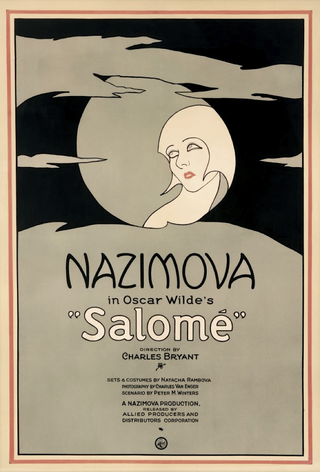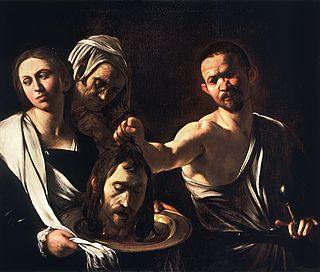
Salomé is a 1922-23 silent film directed by Charles Bryant and Alla Nazimova, who also stars. It is an adaptation of the 1891 Oscar Wilde play of the same name. The play itself is a loose retelling of the biblical story of King Herod and his execution of John the Baptist at the request of Herod's stepdaughter, Salomé, whom he lusts after.

Aubrey Vincent Beardsley was an English illustrator and author. His black ink drawings were influenced by Japanese woodcuts, and depicted the grotesque, the decadent, and the erotic. He was a leading figure in the aesthetic movement which also included Oscar Wilde and James McNeill Whistler. Beardsley's contribution to the development of the Art Nouveau and poster styles was significant despite his early death from tuberculosis. He is one of the important Modern Style figures.

The Yellow Book was a British quarterly literary periodical that was published in London from 1894 to 1897. It was published at The Bodley Head Publishing House by Elkin Mathews and John Lane, and later by John Lane alone, and edited by the American Henry Harland. The periodical was priced at 5 shillings and lent its name to the "Yellow Nineties", referring to the decade of its operation.

Salome, also known as Salome III, was a Jewish princess, the daughter of Herod II, who was the son of Herod the Great, with princess Herodias. She was granddaughter of Herod the Great, and stepdaughter of Herod Antipas. She is known from the New Testament, where she is not named, and from an account by Flavius Josephus. In the New Testament, the stepdaughter of Herod Antipas demands and receives the head of John the Baptist. According to Josephus, she was first married to her uncle Philip the Tetrarch, after whose death she married her cousin Aristobulus of Chalcis, thus becoming queen of Armenia Minor.

Lucas van Leyden, also named either Lucas Hugensz or Lucas Jacobsz, was a Dutch painter and printmaker in engraving and woodcut. Lucas van Leyden was among the first Dutch exponents of genre painting and was a very accomplished engraver.

Salome, Op. 54, is an opera in one act by Richard Strauss. The libretto is Hedwig Lachmann's German translation of the 1891 French play Salomé by Oscar Wilde, edited by the composer. Strauss dedicated the opera to his friend Sir Edgar Speyer.

Salome is a one-act tragedy by Oscar Wilde. The original 1891 version of the play was in French; an English translation was published three years later. The play depicts the attempted seduction of Jokanaan by Salome, step-daughter of Herod Antipas; her dance of the seven veils; the execution of Jokanaan at Salome's instigation; and her death on Herod's orders.

The Dance of the Seven Veils is Salome's dance performed before King Herod Antipas, in modern stage, literature and visual arts. It is an elaboration on the New Testament story of the Feast of Herod and the execution of John the Baptist, which refers to Salome dancing before the king, but does not give the dance a name.
The year 1894 in art involved some significant events.

Salome's Last Dance is a 1988 British film written and directed by Ken Russell. Although most of the action is a verbatim performance of Oscar Wilde's 1891 play Salome, which is itself based on a story from the New Testament, there is also a framing narrative that was written by Russell.

The beheading of John the Baptist, also known as the decollation of Saint John the Baptist or the beheading of the Forerunner, is a biblical event commemorated as a holy day by various Christian churches. According to the New Testament, Herod Antipas, ruler of Galilee under the Roman Empire, had imprisoned John the Baptist because he had publicly reproved Herod for divorcing his first wife and unlawfully taking his sister-in-law as his second wife Herodias. He then ordered him to be killed by beheading.

Salomé is a 1908 opera in one act by Antoine Mariotte to a libretto based on the 1891 French play Salome by Oscar Wilde. However, that work was itself inspired by Flaubert's Herodias. Mariotte began to compose his opera before the far more famous treatment of the same source by German composer Richard Strauss (Salome), but his premiered after the Strauss work.

Hans Henning Otto Harry Baron von Voigt, best known by his nickname Alastair, was a German artist, composer, dancer, mime, poet, singer and translator.

The illustration of manuscript books was well established in ancient times, and the tradition of the illuminated manuscript thrived in the West until the invention of printing. Other parts of the world had comparable traditions, such as the Persian miniature. Modern book illustration comes from the 15th-century woodcut illustrations that were fairly rapidly included in early printed books, and later block books. Other techniques such as engraving, etching, lithography and various kinds of colour printing were to expand the possibilities and were exploited by such masters as Daumier, Doré or Gavarni.

The Climax is an 1893 illustration by Aubrey Beardsley (1872–1898), a leading artist of the Decadent (1880-1900) and Aesthetic movements. It depicts a scene from Oscar Wilde's 1891 play Salome, in which the femme fatale Salome has just kissed the severed head of John the Baptist, which she grasps in her hands. Elements of eroticism, symbolism, and Orientalism are present in the piece. This illustration is one of sixteen Wilde commissioned Beardsley to create for the publication of the play. The series is considered to be Beardsley's most celebrated work, created at the age of 21.

The Apparition(French: L'Apparition) is a painting by French artist Gustave Moreau, painted between 1874 and 1876. It shows the biblical character of Salome dancing in front of Herod Antipas with a vision of John the Baptist's severed head. The 106 cm high and 72,2 cm wide watercolor held by the Musée d'Orsay in Paris elaborates on an episode told in the Matthew 14:6–11 and Mark 6:21–29. On a feast held for Herod Antipas' birthday, the princess Salome dances in front of the king and his guests. This pleased him so much he promises her anything she wished for. Incited by her mother Herodias, who was reproved by the John the Baptist for her illegitimate marriage to Herod, Salome demands John's head on a charger. Regretful but compelled to keep his word in front of everyone present, Herod complies with Salome's demand. John the Baptist is beheaded, his head brought on a charger and given to Salome, who in turn gives it to her mother.

Grenville Lindall Winthrop (1864–1943) was an American lawyer and art collector from New York City. A direct descendant of John Winthrop, the first governor of the Massachusetts Bay Colony, he restored historic buildings in Lenox, Massachusetts, and assembled a large art collection in his Upper East Side townhouse. He bequeathed his entire art collection to the Fogg Art Museum of his alma mater, Harvard University.

Salome Dancing before Herod is an oil painting produced in 1876 by the French Symbolist artist Gustave Moreau. The subject matter is taken from the New Testament, depicting Salome—the daughter of Herod II and Herodias—dancing before Herod Antipas.
"Salome" is a 1968 Australian TV play starring Frank Thring. It was based on the 1891 play of the same name by Oscar Wilde and was reportedly the first time that play had been adapted for television.

Salome by Oscar Wilde, a play written in 1891 and first produced in 1896, has been analysed by numerous literary critics, and has prompted numerous derivatives. The play depicts the events leading to the execution of Iokanaan at the instigation of Salome, step-daughter of Herod Antipas, and her death on Herod's orders.




































